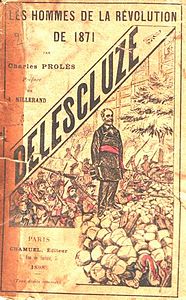Semaine sanglante
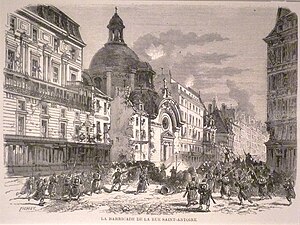
The semaine sanglante ("bloody week"), from Sunday 21 May until Sunday, 28 May 1871, was a short and bloody military campaign by the French Army, led by Marshal Patrice de MacMahon, which recaptured Paris from the Paris Commune. Many Commune prisoners, captured with weapons in hand, were summarily shot by the army. In the final days, the Commune executed about one hundred hostages, including the Archbishop of Paris, Georges Darboy, and burned many Paris landmarks, including the Tuileries Palace, the Hôtel de Ville ;[1] the Ministry of Justice building, the Cour de Comptes, and the Palace of the Legion of Honor.
French Army casualties during the battle were 877 killed and 183 missing.[2] 43,000 Communards were taken prisoner, and 6,500 to 7,500 self-exiled abroad. The number of Communard soldiers killed during the week has long been disputed: Prosper-Olivier Lissagaray put the number at twenty thousand, but estimates by later historians put the probable number between ten and fifteen thousand men, an enormous number for the time.[3]
The Combatants[]
On paper, the Commune National Guard was a formidable army, since all male citizens were required to serve, and many women also took part. In mid-May, the Commune National Guard numbered one hundred fifty thousand men, half in combat units. On the eve of Bloody Week, the National Guard combat forces numbered fifty thousand men, Mostly in advanced positions, near the ramparts; ten thousand on the south line, two thousand to the west, and six thousand by the ramparts in the southwest, the area apparently most threatened. South of the city, about 7500 Communards occupied trenches, facing one division of the Versailles Army, with about the same number of men. A similar number of Communards were entrenched near the Bois de Boulogne, facing a Versailles division. Several thousand National Guard soldiers were kept as a reserve barracks within the city, including three thousand at the Champ de Mars.[4] However, once the fighting began, many thousands of the Commune soldiers, as many as half, simply stayed home, and went into the cellars under their buildings until the fighting was finished. They were taken prisoner after the fighting was over. Historian Jacques Rougerie put the numbers of National Guard fighters who fought actively at just twenty thousand.[5]
The Versailles Army, between the beginning of April and the end of May, grew from 55,000 at the beginning of April to 120,000 men by the end of May. In the beginning, The newly-recruited army had few experienced officers or trained soldiers. This problem was resolved in May, with the release from German prison camps of thousands of experienced soldiers and officers, captured during the Franco-German War, who were released and immediately went into service in the Versailles Army.[6]
Prelude[]
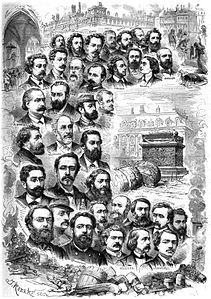
The Commune leaders, with the destroyed Column of the Place Vendome
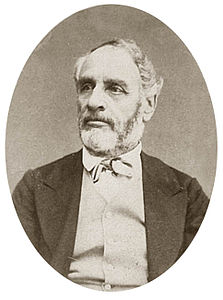
Louis Charles Delescluze, military commander of the Commune during the "Bloody Week"
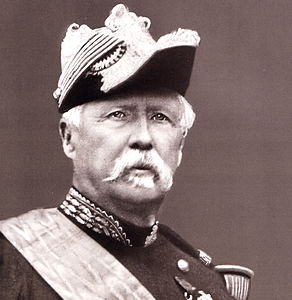
Patrice de Mac-Mahon, commander of French army forces during the "Bloody Week" (1870s)
At the beginning of March a Prussian Army was camped outside of Paris; they had forced the French government to sign a humiliating peace, giving up Alsace and Lorraine, and had triumphantly paraded on the Champs-Élysées on March 1. Soldiers from the National Guard, controlled by the Paris Commune clashed with the French Army on 18 March, when the army tried to remove 227 cannons from a depot on Montmartre. The Commune guardsmen killed two army generals.The red flag of the Commune was hoisted over the Hotel de Ville. Adolphe Thiers, President of France, hurriedly withdrew the government of France from Paris, first to Bordeaux and then to Versailles. this marked the beginning of the campaign to retake Paris and destroy the Commune [7]
The Commune government divided into various political factions, and led by several committees with different political agenda. Most importantly, it lacked a competent commander. In April, the Commune launched an ambitious military expedition against the Versailles government led by Gustave Paul Cluseret, who had had fought with Garibaldi in Italy and had been a general in the Union Army in the American Civil War. The inexperienced soldiers of the National Guard came under fire from the cannons of the fort of Mont-Valerian, broke ranks, and fled back to Paris, reaching the Pont de Neuilly, pursued by the Versailles Army. After the fiasco of Mont-Valerian, Cluseret, resigned on May 1, and was replaced by a Colonel Rossel; but Rossel resigned on May 9, complaining about a government "where everyone deliberates and no one obeys." He was replaced by Louis Charles Delescluze, who led the Commune forces through the Bloody Week. Delescluze was an attorney and journalist, and had extensive political experience, but no military experience.[8]
In the weeks before the Semaine Sanglante, the French army was considerably reorganized and vetted for loyalty. Soldiers suspected of sympathies to the Communards were transferred to other regiments, and often sent to French outposts in North Africa or regions distant from Paris.[9]
On May 8, after heavy fighting. the Versailles occupied Fort Issy, a key defense south of the city, and gradually took several other positions west of the city gates, bringing their trenches and forces directly outside the walls of the city. On Saturday, May 20, they began a heavy artillery bombardment, lobbing shells at the western gates and into the city, particularly the Port de Saint-Cloud. The Commune forces considered themselves safe within the ring of ramparts and fortifications that surrounded the city. On that Saturday a concert was held in the Tuileries Gardens to raise funds for widows and orphans. The concert was accompanied by the sound of the Versailles artillery firing at the Place de la Concorde.
Sunday, 21 May[]
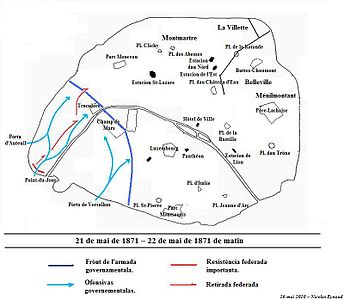
May 21 - Troops of General Douay entered Paris through the Point-du-Jour rampart, which had been left undefended

Army units enter Paris at the undefended rampart of Point-du-Jour

Jaroslav Dombrowski,Polish nobleman and military commander early in the Semaine Sanglante

A Commune artillery battery atop the Arc de Triomphe
When the bombardment of southwest ramparts of the city by the Versailles Army began, many of Commune soldiers who manned the walls were moved back to safer positions, apparently to protect them from the bombardment of the walls by the Versailles artillery, but without the knowledge of the Commune Central Committee,
During the morning or early afternoon of 21 May, an agent of the Versailles government inside Paris explored the neighbourhood near the Point du Jouf in the southwest, and saw that that Point-du-Jour rampart was not manned by Commune troops. He crossed the rampart, and gave the information to the Versailles troops camped just outside the city. A Versailles officer made a quick inspection and verified the absence of Communards on the rampart. General Felix Charles Douay telegraphed notified Marshal MacMahon and the high command, and the army immediately began moving troops through the gap into the city. Once inside the city, the Versailles forces quickly spread out, and captured two major city gates, the Port d'Auteuil and the Port de Versailles, from behind. by the late afternoon sixty thousand Versailles soldiers were inside the city. Passy was quickly occupied, and the Trocadero, before the Commune was fully aware of the danger. The Versailles Army reached the Champs de Mars and the Trocadero. [10]
Dombrowski, the Commune military commander, learned of the breach and immediately sent a message to alert the Commmittee of Public Safety and the Council of the Commune. announcing that he would personally take charge of suppressing it.[11] The dispatch reached the Council of the Commune, which was beginning a debate on a proposal to dismiss the Commune military commander, Cluseret, for incompetence. The head of the Council, Billioray, read the message from Dombrowski to the council: "The Versailles forces have entered by the Gate of Saint-Cloud. I am taking measures to push them back. If you can send me reinforcements, I will be responsible for everything." [12] After a stunned silence, Billioray responded calmly, "The batallions have been sent. The Committee of Public Safety is watching the matter." The council voted to retain Cluseret as commander and then adjourned, without taking any further action. [13]
Despite the artillery bombardment, A charity concert to raise funds for orphans and war victims went ahead in the afternoon at the Tuileries Gardens, and attracted some eight thousand people. It was originally planned for the Place de la Concorde, but was moved to the Tuileries because of the risk of shells falling from the bombardment. At the end of the concert, the master of ceremonies promised that the Versailles troops would never ever the city, and that another concert would be held at the same site the following Sunday.
By the afternoon, as word spread that the Versailles forces were already within Paris, the defending forces, with their headquarters at the Hotel de Ville, began to react. The defense of the city was the responsibility of two separate organisations, the Committee of Public Safety (which took its name from the committee that had conducted the Reign of Terror during the French Revolution) and the Central Committee of the Commune. But they had no comprehensive plan for the defense of the city.[14]
The major defensive activity of the Commune before and during Bloody Week, following the model of the 1848 Revolution, was the construction of barricades. The most imposing barricade was erected on the Rue de Rivoli, at the entrance of the Place Saint-Jacques and the corner of Rue Saint-Denis, to protect the Hotel de Ville, the headquarters of the Commune. It was six meters high and several meters deep, built of paving stones, with a protective ditch an advanced from line, and sheltered firing positions.It was finished in a few hours, Similar barricades had been or built or were begun on square Saint-Jacques, rues Auber, de Châteaudun, Faubourg Montmartre, Notre-Dame de Lorette, at the Trinité, La Chapelle, Bastille, Buttes Chaumont, boulevard Saint-Michel, and at the Panthéon, and others were begun along the length of Boulevard Saint Michel and Rue Saint-Jacques. But the defenders soon ran into a new problem. The Committee of Artillery of the Central Committee argued about which positions had the greatest need for cannons. As a result, many of the barricades were never finished or fully armed.[15]
Once the Versailles troops entered Paris, several factors worked against the Commune. The wide boulevards were not conducive to defensive urban warfare; the factional nature of the Commune led to a lack of unity in the defense of the city; each neighbourhood had its own commander, and there was no incentive to work together. finally, the Versaillais army had superiority in numbers, command, and equipment. Most importantly, the Commune had no experienced military leader, and no plan to defend the city. There was no structure for joint action between the forces of the different neighborhoods. Each part of the city was entirely on its own. By the end of the first day, the Versailles forces had occupied a large part of the west of the city, as far as the Champs de Mars and the Trocadero.
Monday, 22 May[]
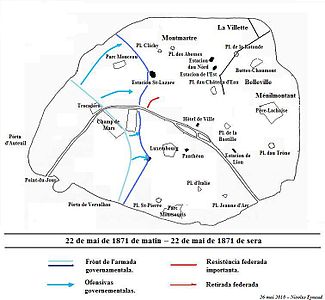
On May 22, the Versailles Army advanced east toward the center of Paris

The Versailles forces enter the city via the Porte de Saint Cloud, pushing further east
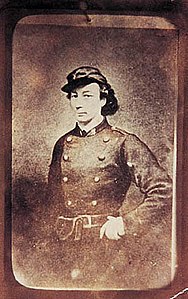
Louise Michel,one of the women soldiers of the Commune, in her uniform

Commune barricade with women soldiers at Place Blanche
At 930 on Monday the 22nd, General Cissey, commander of one wing of the Versailles Army, established his headquarters at the Ecole Militaire, well within the city. Fifty thousand soldiers were already with Paris. [16]
At the commune, the alarm was not formally sounded until early Monday morning. Louis Charles Delescluze issued a proclamation calling on Parisians to rally to the defense of the city.[17] Delescluze was a member of the Committee of Public Safety since May 9, and since May 11 was the civilian delegate of th War Committee, which though he had no military experience, the civilian delegate of the War Committee (11 May), which made him effectively the military leader of the Commune. The proclamation declared, "Enough of militarism! Give place to the People, to the Combatants with arms bare! The alarm of the popular war has sounded! The People know nothing about clever manoeuvres, but when they have a rifle in their hand, and the pavement under their feet, they have no fear of the clever strategies of the monarchist school."[18] The proclamation had the opposite of the intended effect. Instead of joining together into a single force, the troops of the remaining national guards battalions dispersed, each to defend its own neighbourhood. [19]
Other than the soldiers of the National Guard, few Parisians were armed and prepared to fight. Many men who were formally members of the Guard simply stayed home. [20] A women's battalion had been created, which included the activist and future anarchist leader Louise Michel. It was assigned with other national guard units, to defend the Square des Batignolles, or, as other accounts say, Place Blanche, or Place Clignancourt.
Following the entry of the Versailles soldiers into Paris, the Commune soldiers abandoned the Ministry of War, which was near the new front line. They failed to take away or burn the records and documents of the Commune armed forces, which later gave the Versailles government the names and history of all the Commune soldiers. [21]
Only a few barricades were already in place, notably on the Rue Saint-Florentin and Rue de l'Opéra, and the Rue de Rivoli. The Commune defenders concentrated on building new ones; some nine hundred barricades were built hurriedly out of paving stones and sacks of earth. Residents of the neighbourhoods prepared shelters in the cellars. The first serious fighting took place on the afternoon of the 22nd, an artillery duel between regular army batteries on the Quai d'Orsay and the Madeleine, and National Guard batteries on the terrace of the Tuileries Palace.
On May 22, the first documented organised executions of National Guard soldiers by the regular army inside Paris took place at Parc Monceau. Fifteen men and one woman prisoner captured in combat were shot immediately after the battle. The practice of shooting prisoners was not consistent or universal. Some units never shot prisoners; other shot prisoners immediately in some cases, but in later battles handed over prisoners for judgement to the military courts.[22] [23]
By the evening of the 22nd, the Versailles forces had reached the Gare Saint Lazare and the Place de la Concorde, and had occupied the Gare Montparnasse. General MacMahon, the commander of the Versailles forces, established his headquarters near Trocadero. The head of the Versailles government, Adolphe Thiers, entered the city and visited MacMahon at his command post that afternoon.[24] [25]
The Polish nobleman Jaroslav Dombrowski was still formally the senior military commander of the Commune, but rumours had been spreading that he had received a large bribe in exchange for the to surrender the city to the Versailles forces. His advice and commands were largely ignored. At ten o'clock in the evening, a group of Commune officers escorted Dombrowski to the Hotel de Ville to turn him over for judgement by the Committee of Public Safety. "They say I was a traitor!" Dombrowski cried. The Committee of Public Safety accepted his explanation and reassured him. That evening Dombrowski had dinner with a group of officers, and, without speaking, shook all of their hands. They understood that he intended to go into combat immediately, to seek death his own way. [26]
Tuesday, 23 May[]


Commune cartoon from May 1871 depicting Jaroslav Dombrowski chasing away the Versailles Army
On the 23th, the primary activity of the Commune was building or strengthening barricades, mostly made by pulling up the paving stones of the Paris streets. Hundreds of men and women were engaged in the labor. Early in the morning the army resumed its offensive toward the east. The French army had learned important lessons in street fighting during the 1848 French Revolution, particularly the way to overcome barricades. Instead of attacking them head-on, the army moved slowly and systematically, systematically tunneling through walls of buildings around the barricades and positioning soldiers on the upper floors buildings above and behind the barricades. The Barricades could then could be assaulted from the sides or rear. In most cases, the barricades that were outflanked were abandoned, with no need from a frontal attack. The Communards also tried the same strategy, but lacked lacked the tools and manpower to tunnel through interior walls.
The strongest resistance against the Versailles army on the 23rd was in Montmartre, where the Commune had originally been launched. Extensive barricades had been built at Place Blanche and at Square Jacques, whose defenders included women soldiers, A large number of cannon had been captured by the Communards from the Army at Montmartre at the beginning of the Commune, and they were still there, but the Communards had no ammunition for them. Commune soldiers Place Clichy and Place des Abbesses, were able to repulse several attacks by the army But the Versailles forces received agreement from the Prussian Army, which controlled the zone outside the city walls, to move troops along the city walls to outflank the Commune forces. Pleas for reinforcement and munitions for Montmartre were sent to the Commune headquarters at the Hotel de Ville, where they were given promises, but no reinforcements or ammunition. They anticipated frontal attacks, but the Versailles forces worked their way around and behind the barricades, forcing the Communards to withdraw. By the end of the day the army effectively controlled half the city, along a line from Montmartre on the north to Parc Montsouris in the south.[27]
The most competent military leader of Commune,Jaroslav Dombrowski, found his occasion to prove to Commune skeptics that he was never collaborator with the Versailles forces. He went to the middle of the most violent fighting, where very shortly he was fatally wounded. He died in the ambulance taking him back to the command center. His last reported words were, "Do they still say I was a traitor?"[28]
In the evening, in desperation and lacking an effective strategy to repel the Versailles forces, the Communards adapted a new tactic; they began setting fire to the government buildings they still controlled, beginning with the Tuileries Palace. A group of arsonists spread through the building, soaking the interior with oil, and set it on fire. The buildings set on fire by the Commune, besides the Hotel de Ville and Tuileries Palace, included the Ministry of Justice (which was also damaged on the outside by artillery fire from the Versailles army) the Ministry of Finance, the Cour des Comptes, the Palace of the Legion of Honor and the Gobelins Manufactory, the Palais d'Orsay. and the commercial piers along the Seine. They began to set a fire at Notre Dame de Paris, but were stopped when it was observed that the fire would destroy the neighbouring Hotel did Dieu hospital, where several thousand patients wer being treated.[28]
Wednesday, 24 May[]
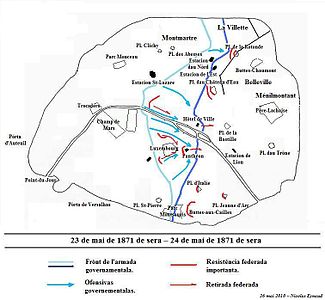
By the end of the 24th, the Versailles forces had captured Montmartre, where the uprising originally began

Fires were set by the Commune at Tuileries Palace and surrounding buildings on the night of May 23–24

May 24 - Barricade Fighting on Rue de Rivoli, with fires blazing. In reality, the army rarely made frontal attacks on barricades, preferring to work around them and attack from above and behind.

Georges Darboy, Archbishop of Paris, executed with five other hostages by a Commune firing squad on 24 May.
Early in the morning on the 24th, as the army came closer, the Commune leaders decided to abandon their headquarters at the Hotel de Ville in the center of the city, and move to the city hall of the 11th arrondissement. They set fire to the building, gutting not only the historic structure but also destroying city archives and property records stored inside. This left the Commune without a central command post. Each neighbourhood was on its own.
Commune soldiers were building a bonfire of the chairs and furnishings of Notre Dame de Paris, preparing to burn the cathedral, following the example of the Tuileries Palace and other government buildings. At three in the morning, an official arrived from the Commune headquarters. He pointed out that a fire in Notre-Dame was certain to set fire to the neighbouring Hotel-Dieu Hospital, which held eight hundred patients. The fire was put out and the cathedral was evacuated, and spared from bombardment through the rest of the Commune.[29]
The remaining government body of the Commune, the Central Committee, issued ia manifesto with its own conditions of peace for delivery to the Versailles military headquarters. They proposed the dissolution of both the Commune and the National Assembly, the withdrawal of the army from Paris, the election of new governments in the large cities, and a general amnesty. This was posted on the walls of the city still controlled by the Commune. The army headquarters ignored the manifesto and continued its methodical reconquest of the city.[30]
On the 24th, a delegate led by Gustave Genton, a member of the Committee of Public Safety, came to the new headquarters of the Commune at the city hall of the 11th arrondissement and demanded the immediate execution of the prisoners held as hostages at the prison of La Roquette. The new prosecutor of the Commune, Théophile Ferré drafted an "Order to the Citizen Director of La Roquette to execute six hostages." Genton went to the prison and was given a list of hostages from which he selected six names. including Georges Darboy, the Archbishop of Paris, and three priests. The governor of the prison, M. François, refused to give up the Archbishop without a specific order from the Commune. Genton sent his deputy back to Ferré who wrote "and especially the archbishop" on the bottom of his note. Archbishop Darboy and five other hostages were taken out into the courtyard of the prison, lined up against the wall, and shot.[31] After the end of the Commune, Ferré was singled out for prosecution because of his order, and was one of two dozen Commune leaders who were executed. In total, the Commune executed about one hundred hostages.[32]
Thursday, 25 May[]

By the 25th, Montmartre had fallen, and the fighting had moved well into the east end of the city
On the 25th, Commune leader Louis Charles Delescluze, showed himself on top of a barricade and was promptly shot dead.
By the morning of Thursday, May 25, the entire west portion of the city was controlled by the Versailles Army. During the night of the 24th-25th, the Communards, who had too few troops to hold such a long line, withdrew from their barricades in the 10th arrondissement, taking their cannons with them. By morning these positions were quickly occupied by the Versailles troops. On the left bank, the Versailles army occupied the Luxembourg gardens and moved up cannon. A force of Communards led by Wroblewski counterattacked in Asnieres and Neuilly, pushing back the Versailles army and cadpturing three cannon. But on the right bank the Versailles army continued to move forward. Wroblewski tried to hold onto his positions, but the Versailles army was already moving past him. In a short time the army captured the ruins of the Hotel de Ville, and moved on toward the Place de la Bastille, the central strong point of the Commune lines. Instead of attacking the barricades directly, the spread out and worked their way through the narrow streets around it, tunnelling through walls and outflanking the Commune positions.[33]
In the center of the right bank, the Versailles army pushed along the avenues toward the Place d'Italie, via Avenue d'Italie and Avenue de Choisy, which were blocked by massive barricades. The Communards created a distraction bye setting fire to the enormous Gobelins tapestry factory. Nonetheless the Versailles soldiers bypassed the barricades by moving through the numerous gardens in the neighbourhood. By this means they were able to outflank the powerful Commune position at the Butte-aux-Cailles.[34] The Commune soldiers captured a group of a dozen Dominican monks (Whom the Commune historian Prosper Lissagaray described as "agents of the Inquisition"), who were fleeing the city, and later shot them.[35]
At the southern edge of the city, the Communards still held two powerful forts, Montrouge and Bicetre, which prevented the Army from encircling the Communards in the south. The Communard garrisons of the two forts decided on their own to abandon them, so they could return home and defend their own neighbourhoods. Without waiting approval, they spiked the cannon and departed. The two forts were quickly occupied by the Versailles troops, who brought their own cannon and began to bombard the Communard positions at Fort Ivry and Butte-aux-Cailles.[36]
By the end of the day, the Versailles forces commanded the entire left bank. The main Communard force, led by Wroblewski, was able to escape to the right bank with protection from cannon on the Austerlitz bridge. The new front lines were at the Bastille and the Place Chateau d'Eau, where bitter fighting took place on the barricades.
Delescluze and the remaining Communard leaders had moved their headquarters to the city hall of the 13th arrondissement on rue Voltaire, but this neighborhood also was soon under attack by the army. Late in the afternoon, Delescluze met with the military commander Wroblewski, and offered him the post of commanding general of the Commune. Wroblewski politely declined, saying that, under the circumstances, he preferred to fight as a private soldier. The Versailles forces encircled and captured the Conservatory of Arts and Metiers, and other key positions. The front line moved to the barricade at the Chateau d'Eau. [37]
At about 7:30 in the evening on the 25th, Delescluze put on his ceremonial sash as the chief executive of the Commune, and walked to the barricade at the Place Chateau d'Eau. Unarmed, he climbed up to the top of the barricade, in clear view of the Versailles soldiers, and was promptly shot dead.[38]
Friday, 26 May[]


Photomontage of the execution sixty-four hostages by the Commune at Rue Haxo
During the night of May 25-26, the Versaille army quietly occupied several strategic points abandoned by the Commune, including the barricade on Rue Saint-Antoine at at the corner near Rue Castex, the Gare de Lyon railway station, the prison of Mazas, the Square du Temple, and reached boulevard Voltaire. The fighting resumed at seven o'clock on Friday morning, under a heavy rain. The major Commune strong points were the barricades at the Place de la Bastillein the center and the Place de la Rotonde, in the northeast. As on the previous days, the army did not venture a direct attack on the barricades, but slowly and methodically worked its way around them. The Communards resisted fiercely, particularly on the Fabourg Saint-Antoine, but they were subjected to a heavy bombardment from Versailles batteries. The barricades were gradually outflanked, and the Place de la Bastille was taken by the Versailles forces at about two in the afternoon. Place de la Rotonde held out longer, but was outflanked by Versailles forces on both sides. The Versailles artillery batteries were poised on the heights of Montmartre. and coordinated their fire, with the troops below. The cannon of the Communards tried to resist the advancing army, but there was no communication or coordination between the units and the batteries Commune artillery. Each cannon or battery of cannon was on its own.[39]
In the afternoon, a dozen members of the Commune Central Committee held a rare meeting at Rue Haxo in the 20th arrondissement. The rival government body, the Committee of Public Safety, had largely disappeared. The Central Committee drafted a proclamation, calling upon the citizens of the arrondissement to aid the Communards in the neighbouring 19th arrondissement in expelling the Versailles forces. "Therefore, forward!" It concluded. "Vive la Republique!" It was the last proclamation issued by the Commune.[40]
At six in the evening, a group of sixty-two or sixty four hostages collected by the Commune was brought to Rue Haxo near Belleville, including clergymen and thirty-four gendarmes. An angry crowd gathered. The hostages were lined up against the wall and shot. [41][42]
The remaining Commune soldiers were reinforced by retreating soldiers from other neighbourhoods, who occupied an imposing group of barricades.
By the end of the 26th, resistance was ended on the Left Bank. The Commune-held area was limited to a hemicircle in the northeast, including the Buttes de Chaumont and the Pere Lachaise cemetery,La Rotonde and Belleville were the remaining Commune strongholds.
Saturday, 27 May[]

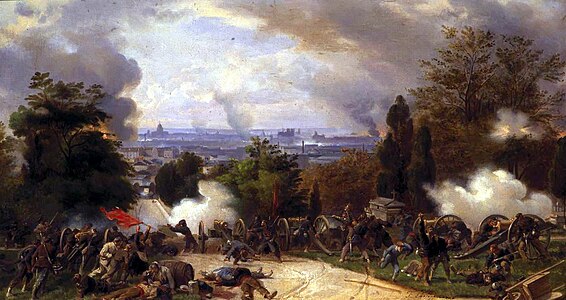
Fighting in Pere Lachaise cemetery 27 May

Combat in Pere-Lachaise on May 27 (Le Monde Illistrated)
By Friday night, the area controlled by the Commune had been reduced to an area of the 20th arrondissement in the northeast, around the working class neighbourhoods of Belleville and Menilmontant The major defensive points were the Quarry of the Americas or Buttes-Chaumont, with hilly terrain and a network of former mines, and the immense cemetery of Pere Lachaise. The Commune forces in the arrondissement were commanded by Ranvier. The north and eastern border of the Commune territory was under Prussian occupation. Beginning on Thursday, the Prussians had reinforced their units, brought in artillery, and sealed off the border of the City. The Communards could no longer enter the district from outside Paris, or escape from the city.[43]
The remaining members of the Central Committee of the Commune, whose territory had shrunk to this one neighbourhood, had converged on Belleville and began to give orders and directives to Ranvier. Ranvier devoted his attention to the last defenses of the neighbourhood. The Communards still had a rectangle of of imposing barricades defending La Villette, Belleville, Menilmontant and Charonne, controlling the grand boulevards. The wide boulevards built by Napoleon III actually gave the Communards an advantage in this neighbourhood, creating clear lanes of fire. They also had batteries of artillery emplaced in hills at Buttes-Chaumont and and Pere-Lachaise. Plus there was no place behind them where they could retreat. Therefore the fighting in this area was some of the most intense of the Semaine sanglante, though overall army casualties were low. The Second Division of the Fifth Corps of the Versailles Army lost three soldiers killed on May 22; six on may 23; four on May 24; then sixteen on may 25, when they attacked the strong defenses of the Arts-et-Metiers quarter; three on May 26, one on May 27, and one on May 28, the last day of combat. [44]
The strong defense in this area caused MacMahon to modify his plan on the 26th; he held back his forces in the south on the Canal Saint Martin and shifted his major attack to encircle the remaining strong points the northeast. Part of his army moved along the walls of the city to attack the Communards from the rear. The Commune barricades on the Place de la Rotonde were encircled and forced to surrender. The army losses were twelve dead and forty-eight wounded.
The fighting resumed that night, as Commune soldiers attacked north of Belleville and at Pere Lachaise. The last units of the Commune were gathered on the streets around the boulevards of Belleville and Menilmontant and and tried to push the Versailles Army out of their positions, but without success. The Versailles Army closed in on them from three sides. The fighting continued through most of the night, but by morning the cemetery was still controlled by the Army.
The other Commune strong points were also forced to surrender under the coordinated onslaught of infantry and artillery. The Versailles Army took 1500 prisoners on Rue Haxo, and two thousand prisoners near Pere Lachaise.
The Second Division of the 5th corps was able to capture 93 barricades in the course of the week, as only ten were fully defended, and forty-one were not defended at all. The Division of six thousand men lost only thirty-five men killed and two hundred seventy two wounded during the Bloody Week.[45]
One hundred forty-seven prisoners were taken by the army in the final fighting at Pere Lachaise. They were lined up against the wall of the cemetery in groups, and shot, and buried in common graves. A smaller group consisting of about twenty officers of the National guard was collected at Mazas Prison and La Roquette prison. They were given brief trials before the military tribunal, sentenced to death, and then delivered to Pere Lachaise. There they were shot and buried in the same grave as the others executed at the cemetery. The wall is now marked with a plaque to the victims of the Bloody Week, and is the site of annual commemorations of the event.[46]
Sunday, 28 May[]

The last major fighting took place near the Pere Lachaise cemetery, the Buttes-Chaumont and Belleville.

Soldiers check the hands of prisoners in Belleville to see if they had fired weapons
Fighting continued around Belleville and Menilmontant and near Pere Lachaise well into the night of May 27-28, but by the morning the Versailles units who had moved along the walls behind the Commune positions completed their encirclement. and the remaining Commune forces were trapped. Nonetheless the Commune units continued fighting on Rue Angouleme (now Rue Jean-Pierre Timbaud). The remaining Commune leaders were all trapped within this pocket; Jules Vallès at the bottom of Rue de Belleville, Eugene Varlin and Charles Theophile Ferré]] at the Faubourg-du-Temple. Outnumbered and surrounded, the remaining Communard soldiers continued to fire from the windows of the ruined buildings. The Versailles artillery on the heights above joined the battle, bombarding the remaining Communard positions. The barricade at the rue de Belleville had to be given up. The Communards there still holding weapons were captured and executed. The Communards fell back to the another barricade on the Faubourg du Temple, then to rue Saint Maur, where they finally surrendered. The one-hundred fifty survivors were taken prisoner.[47] Scattered fighting continued until the evening. A final barricade was captured rue de Tortille at eight at night.[48]
Fifteen hundred Commune prisoners surrendered on Rue Haxo. Two thousand more surrendered near Pere-Lachaise. At Place Puebla, another eight hundred negotiated their own surrender. These prisoners were spared, and were later marched to Versailles for trial.[49] The Chateau de Vincennes was the last major outpost of the Commune to surrender on the 28th. The Commune soldiers there were imprisoned, while the officers were tried and summarily executed in the moat of chateau. Within Paris, the body of the Commune military leaders, Delecluze, was recovered. General Douay gave instructions to put the body of Delescluze into a common grave with the other Commune soldiers.[50]
Aftermath and legacy[]

Rue de Lille and Rue de Bac after the fighting ended

Place de la Bastille after fighting ended

Grand Salle of Council of State in the Palais d'Orsay after Bloody Week. It was later replaced by the Musée d'Orsay

Ruins of the Palace of the Legion of Honor

The burnt-out Hotel de Ville
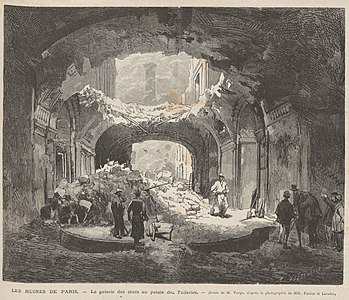
Interior of the Tuileries Palace

Rue Royal after the fighting
On 29 May, the Fort of Vincennes, at the edge of the city, surrendered. The soldiers of the garrison were taken prisoner, while the nine officers of the garrison were shot in the moat of the chateau.
Following the end of the fighting, arrests were made on a massive scale, and continued throughout June. All buildings were searched and all weapons were confiscated. To prevent the soldiers occupying the city from becoming too sympathetic to the Parisians, the camps of the army units were moved out of the city, and contacts were restricted between Parisians and the army. The police took over responsibility from the army, and the army was quickly withdrawn from the city.[51]
Thirty-eight thousand prisoners were taken, including five thousand former soldiers. who had not taken part in the fighting. They were marched to Versailles, in outbuildings of the former Palace, where they were kept until they processed and released. Eleven thousand of those captured were put on trial before military courts. In the end, five thousand were sent to penal colonies in New Caledonia. 1,400 were tried and judged by military courts, and three were executed.[52]
Trials, Executions, and eventual Pardon[]

Execution of Commune prisoners at the Luxembourg gardens
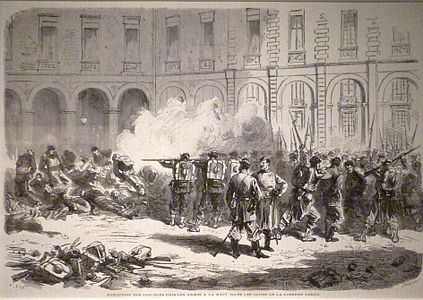
Execution of Commune prisoners at Lobau Barracks
Even before the Bloody Week, executions of prisoners brought complaints from officers that the executions created "a painful impression among the population who claim that we are shooting en masse and without judgement." In response, on May 5 General Cissey, following orders of Marshal Mac-Mahon, issued an order to his generals forbidding any executions of deserters or insurgents after the end of combat. Following this instruction, prisoners were to be divided into categories, such as foreigners, army deserters, those already condemned by a military court, and those who had volunteered for service in the Commune. For a short time executions were halted. However, once the army entered Paris, the army was overwhelmed by the number of prisoners, for which no preparations had been made. A new system was hastily organised where prisoners were sent to the Ecole Militaire, Parc Monceau, Place Vendome and other locations to be guarded and processed. Firing squads were organised, and summary trials and executions began at designated sites, including Parc Monceau and later at the Pere Lachaise Cemetery.
Many Commune prisoners were executed immediately after they were captured, at the place of battle, particularly if they were captured with a weapon or if powder burns on they showed that they had recently fired a weapon. This was not practiced in all units, but was not uncommon. Another large number were taken after their capture to one of the headquarters of the Versailles army, for a summary court martial. There were fifteen such headquarters, at locations including the Pantheon, the Luxembourg Palace, the Cluny theater, the Gobelins tapestry workshop, the city halls of the first and fifth arrondissement, the Ecole Polytechnique and the Ecole des Arts et Metiers. These prisoners were given a brief hearing, and either held for transfer to Versailles for trial, or executed by a firing squad.
After Bloody Week, the bodies of 8509 Communard soldiers killed in the fighting were collected by city authorities for burial in city cemeteries. The largest numbers of registered graves of Communards in Paris are found at Montparnasse (1644 graves), Montmartre (1245 graves), and the Carrières d'Amerique (1338 graves) and Pere-Lachaise (878 graves).[53] Additional previously unrecorded graves were later found at Charonne Cemetery, outside of Paris near Pere Lachaise (800 or 900 graves). A scattering of Additional unrecorded burial sites were found in later years during building excavations, and the construction of Paris Metro. overall,the largest number were buried at Montparnasse cemetery.[54] Of these 452 were shot at the various military headquarters; 449 died in ambulances or hospitals, and 783 were collected from barricades and battle sites around the city. One-hundred sixty-five came from one site, the Pantheon, including those who had been killed in combat, and those who had been summarily executed after the fighting. The historian Robert Tombs concluded that probably a quarter to third of the Commune dead were shot by firing squads of the military courts at the fifteen different military headquarters around the city. [55]
Certain types of prisoners, particularly deserters from the regular army and foreigners, those captured with weapons in their hands, or those whose hands showed they had fired weapons, were almost always selected for immediate execution. Those who laid down their weapons were supposed to be spared. Adolphe Thiers, the head of the Versailles government, declared on May 8, "As to the insurgents, assassins excepted, those who lay down their arms will be spared." MacMahon also declared, "When a man lays down his arms, he should be spared," and regretted the execution of those prisoners who had given up their weapons, but neither Thiers nor MacMahon condemned the execution of soldiers who were still armed. On May 25 General Cissey ordered that "...men captured with weapons in hand should be executed." On June 3, after Bloody Week, Cissey was named by Thiers the new French Minister of War. "We can conclude" Tombs wrote, "that an important proportion of the deaths during the Bloody Week, very probably a majority of those shot, were victims of massacres that were organised and quasi-legal."[56]
The total number of Commune soldiers killed during the Semaine sanglante has been a subject of controversy since the fall of the Commune It was estimated in 1879 by the radical socialist journalist Camille Pelletan at thirty thousand.[57], and by the writer and Commune participant Prosper-Olivier Lissagaray as over twenty thousand. [58] It is estimated by more recent historians to be between ten and fifteen thousand or possibly as high as twenty thousand.[59] Whatever the actual figure was, it was an enormous number for the time. During the three days of the Battle of Gettysburg in July 1863, the deadliest battle of the American Civil War, a total of 7,863 soldiers. both Confederate and Union, were killed, or about half as many as the Commune casualties.[60] It also may have equaled or exceeded the number executed during the Reign of Terror during the French Revolution.[61] 16,594 official death sentences had been carried out throughout France following June 1793.[62]
The Commune itself executed about one hundred hostages, including the Archbishop of Paris, Georges Darboy, a large group of gendarmes, and a smaller group of priests. [63]
The process of arresting, trying and punishing Commune members continued well after the "Bloody Week." Altogether, 43,522 Communards were taken prisoner, largely because the Communards had neglected to burn the register of the Commune forces, which captured near the beginning of the Bloody Week. The prisoners included 819 women and 538 soldiers under the age of sixteen. The prisoners were marched to Versailles, where they were kept in the outbuildings of the Palace. 13,500 were found guilty. 2,245 were acquitted. Twenty-three, including Commune leaders such as Ferré and Rossel, were sentenced to death and executed. Two-hundred fifty one prisoners were sentenced to forced labor, and 1,169, including a number of women, to deportation, mostly to New Caledonia. Of those aged under sixteen years,fifty-eight were found guilty and sentenced to prison terms. [64] [65]
Several thousand Commune supporters, including several of the leaders, fled abroad, mostly to England, Belgium and Switzerland. All the prisoners and exiles were pardoned in 1880 and returned home, and a few resumed political careers and won public office.[66]
Notes and citations[]
- ^ Milza, 2009, pp. 397–398
- ^ Brown, Howard G. (2019). Mass Violence and the Self: From the French Wars of Religion to the Paris Commune. Cornell University Press. p. 271. ISBN 978-1-5017-3070-2.
- ^ Audin, Michele, La Semaine Sanglante, Mai 1871, Legendes et Conmptes, Libertalia Publishers (2021) (in French)
- ^ Tombs, Robert, "La Guerre Contre Paris" (2021), p. 308-309
- ^ Rougerie, Paris Libre (1871), p. 248
- ^ Tombs, Robert, "La Guerre Contre Paris" (2021), p. 258
- ^ Fierro, Alfred, "Histoire et Dictionnaire de Paris" (1996), p. 200
- ^ Fierro 1996, p. 203.
- ^ Tombs (2021), p.118
- ^ Milza, 2009, pp. 379–380
- ^ Lissagaray (1896), p. 311
- ^ Lissagaray (1896), p. 311
- ^ Lissagaray (1896), p. 311
- ^ Lissagaray (1896), p. 311
- ^ Lissagaray (1896), p. 321
- ^ Tombs, "La guerre contre Paris", p. 320
- ^ Proclamation de Delescluze. delegue a la Guerre, au peuple de Paris, Journal officiel, 22 May 1871
- ^ Tombs, Robert, "La Guerre Contre Paris", p. 325-26
- ^ Rougerie, Jacques, "La Commune de 1871 (1988), p. 115
- ^ Da Costa, Gaston, La Commune vecue, 3 vol. Paris, Librairies-impremeries reunies, 1903–1905, III, p. 81. Serman, William, La Commune de Paris, p. 348
- ^ Lissagaray, "Histoire de la Commune de 1871" (1896), p. 323
- ^ Tombs, "La guerre centre Paris (2021), p. 379,
- ^ Milza, Pierre, "La Commune", p. 391
- ^ Tombs, "La Guerre Contre Paris", p.323
- ^ Rougerie, Jacques, "La Commune de 1871" (1988), p. 116
- ^ Lissagaray, "Histoire de la Commune de 1871" (1896), p. 323
- ^ Lissagaray, "Histoire de la Commune de 1871" (1896), p. 323
- ^ a b Milza 2009, p. 394
- ^ Lissagaray (1896) p. 338.
- ^ Lissagaray (1896), p. 337
- ^ Milza, 2009, pp. 403–404
- ^ Milza, 2009, pp. 403–404
- ^ Lissagaray (1896) p. 349-351
- ^ Lissagaray (1896) p. 349-351
- ^ Lissagaray (1896) p. 352
- ^ Lissagaray (1896) p. 349-351
- ^ Lissagaray (1896) p. 349-356
- ^ Lissagaray (1896) p. 349-356
- ^ Lissagaray, "Histoire de la Commune de 1871" (1896), p. 364
- ^ Lissagaray, "Histoire de la Commune de 1871" (1896), p. 364
- ^ Lissagaray, "Histoire de la Commune de 1871" (1896), p. 366
- ^ Tombs, "La Guerre contre Paris" (2021), p. 351
- ^ Lissagaray (1896), p. 364
- ^ Tombs, "La Guerre Contre Paris" (2021), p. 352
- ^ Tombs, Robert, "La Guerre Contre Paris", p. 360.
- ^ Tombs, Robert, "la guerre contre Paris", p. 360.
- ^ Tombs, "La guerre contre Paris" (2021), p. 357
- ^ Tombs, "La guerre contre Paris" (2021), p. 358
- ^ Tombs, "La guerre contre Paris" (2021), p. 357
- ^ Tombs (2021), p. 413
- ^ Tombs (2021), p. 414-415
- ^ Tombs (2021), p. 417
- ^ Audin, "La Semaine Sanglante" (2021), p. 147
- ^ Audin, "La Semaine Sanglante" (2021), p. 147
- ^ Tombs, "La Guerre Contre Paris", p.432-434
- ^ Tombs, "La Guerre Contre Paris", p. 434
- ^ Audin, Michele,"La Semaine Sanglante", p. 9
- ^ Lissagaray, Prosper-Olivier, "Histoire de la Commune de 1871" (1896), p.383
- ^ Tombs, Robert, "La Guerre contre Paris" (2021), p. 421.
- ^ Sears, Stephen W., Gettysburg. Boston: Houghton Mifflin, 2003. ISBN 0-395-86761-4
- ^ Tombs, Robert, "La Guerre contre Paris" (2021), p. 421
- ^ Tombs, Robert, "La Guerre contre Paris" (2021), p. 421
- ^ Milza, 2009, pp. 403–404
- ^ Tombs, Robert, "La Guerre Contre Paris" (2021), p. 192
- ^ Lissagaray (1896), p. 316
- ^ Milza, 2009, pp. 431–432
Bibliography[]
In French[]
- Audin, Michele, La Semaine Sanglante, Mai 1871, Legendes et Conmptes, Libertalia Publishers (2021) (in French)
- Rougerie, Jacques (2014). La Commune de 1871. Paris: Presses universitaires de France. ISBN 978-2-13-062078-5.
- Fierro, Alfred (1996). Histoire et Dictionnaire de Paris. Paris: Robert Laffont. ISBN 2-221-07862-4.
- Rougerie, Jacques (2004). Paris libre 1871. Paris: Editions du Seuil. ISBN 2-02-055465-8.
- Lissagaray, Prosper-Olivier (200). Histoire de la Commune de 1871 (1876). Paris: La Decouverte/Poche. ISBN 978-2-70-714520-8.
- Milza, Pierre (2009). L'année terrible: La Commune (mars–juin 1871). Paris: Perrin. ISBN 978-2-262-03073-5.
- Tombs, Robert (2021). La guerre contre Paris -1871: l'ármée met fin à la Commune. Paris: Flammarion. ISBN 978-2-0802-4351-5.
In English[]
- Tombs, Robert. The Paris Commune 1871 (Routledge, 2014).
Further reading[]
- Brown, Howard G. (2018). "The Paris Commune and the "Bloody Week" of 1871". Mass Violence and the Self. From the French Wars of Religion to the Paris Commune. Cornell University Press. pp. 161–215. ISBN 978-1-5017-3072-6. JSTOR 10.7591/j.ctt21h4x01.9.
- Tombs, Robert (2012). "How Bloody Was La Semaine Sanglante of 1871? A Revision". The Historical Journal. 55 (3): 679–704. doi:10.1017/S0018246X12000222. ISSN 0018-246X. JSTOR 23263269. S2CID 159831886.
- Paris Commune
- May 1871 events
- Massacres in the 1870s
- Massacres in France
- Battles involving France
- Conflicts in 1871


















